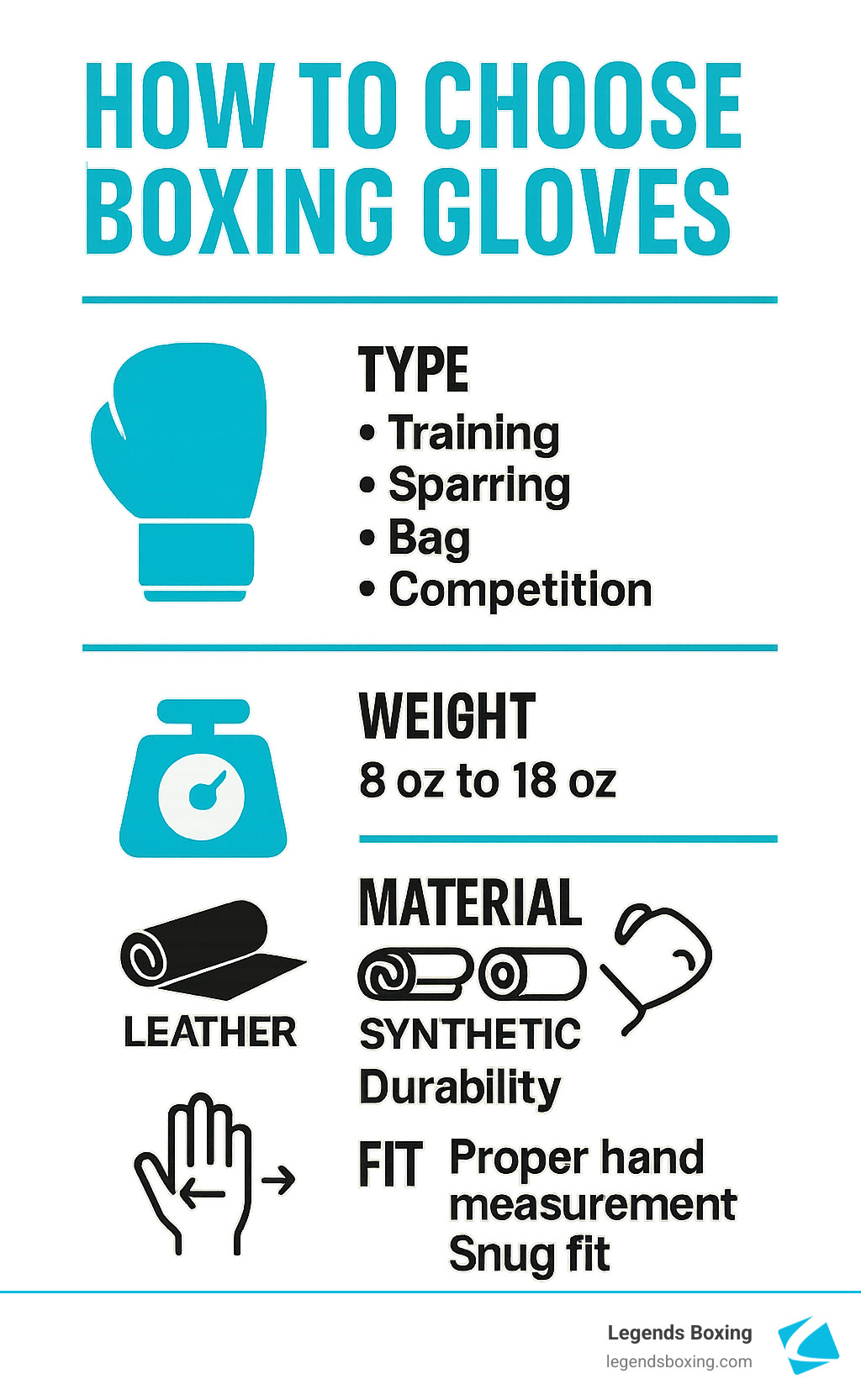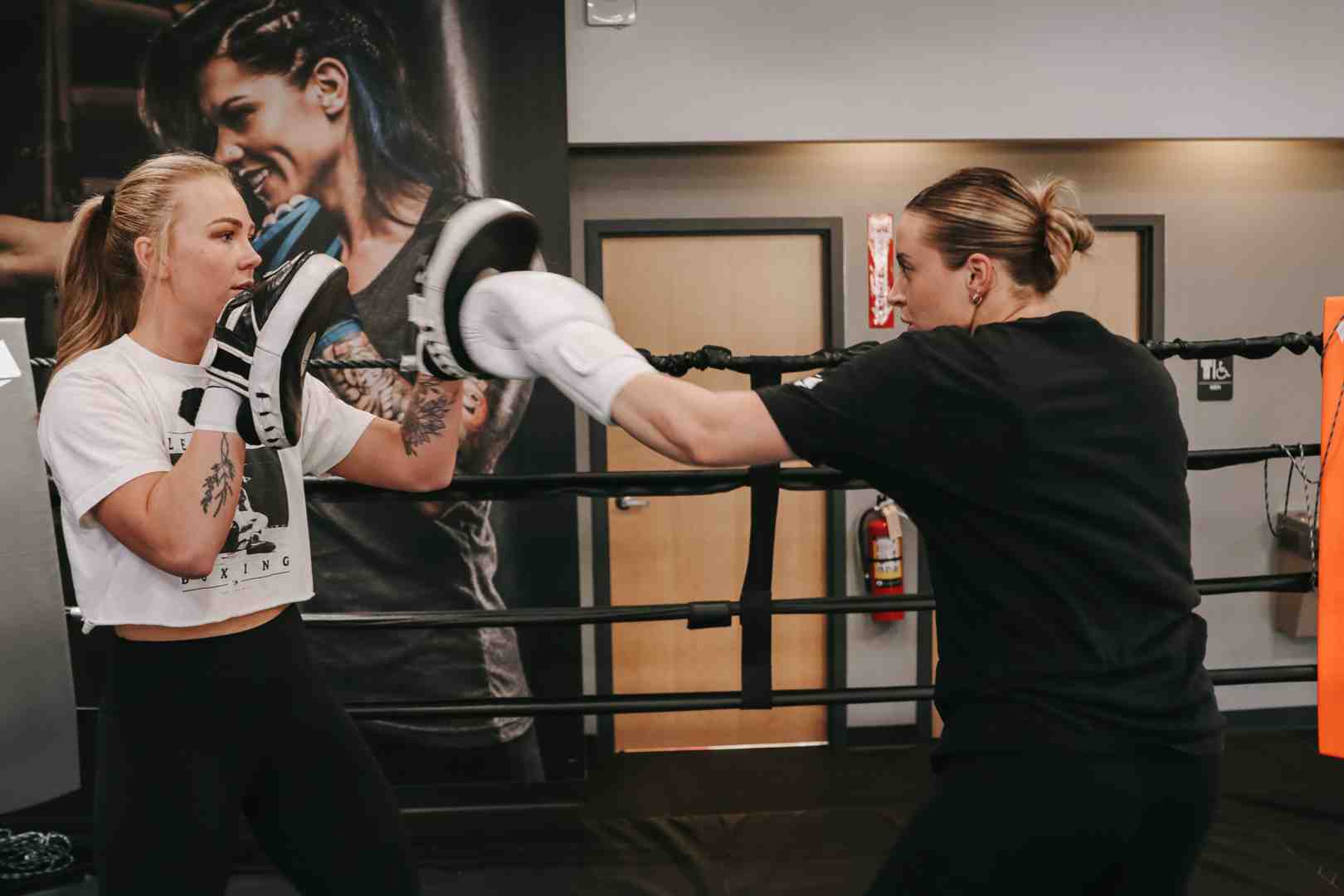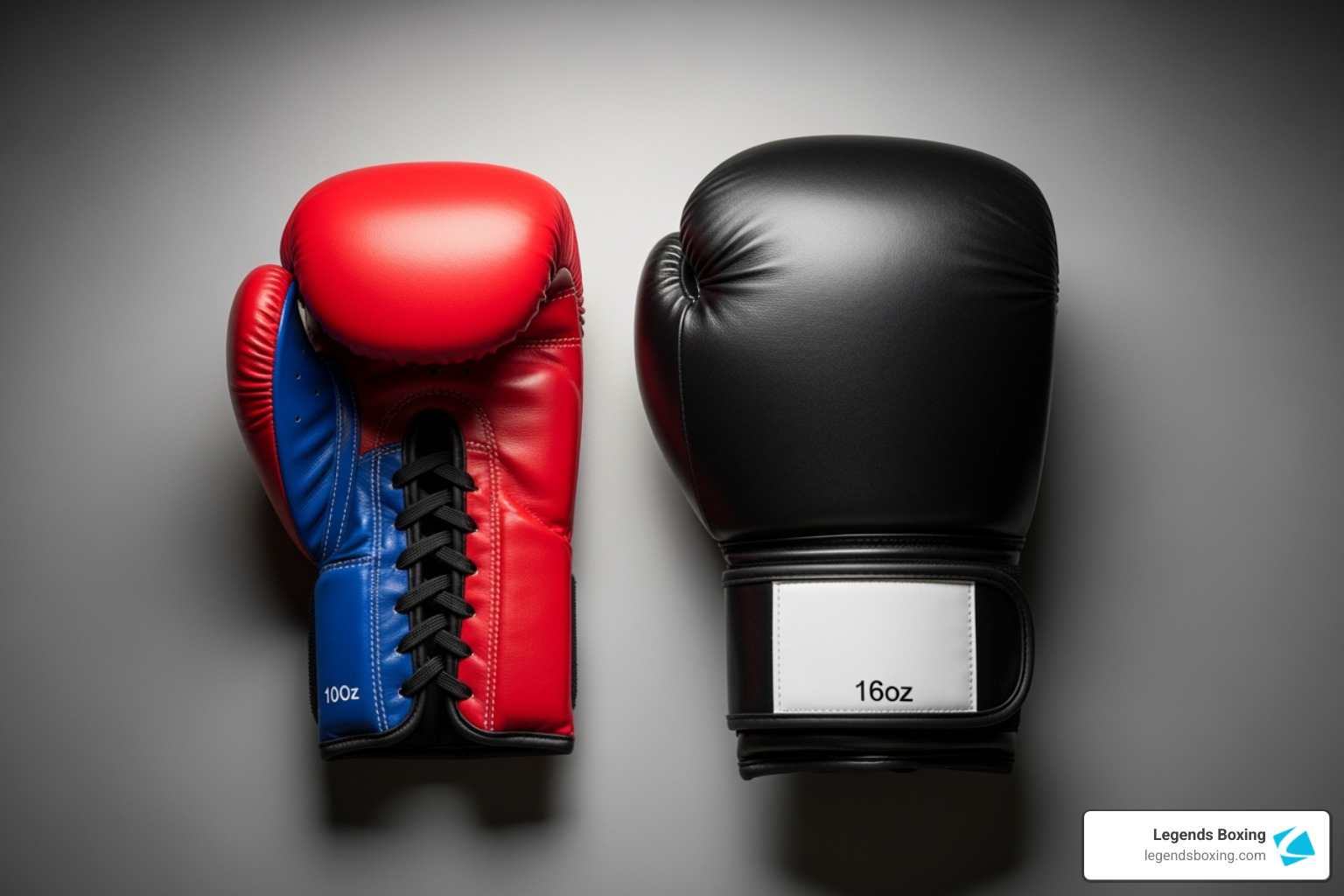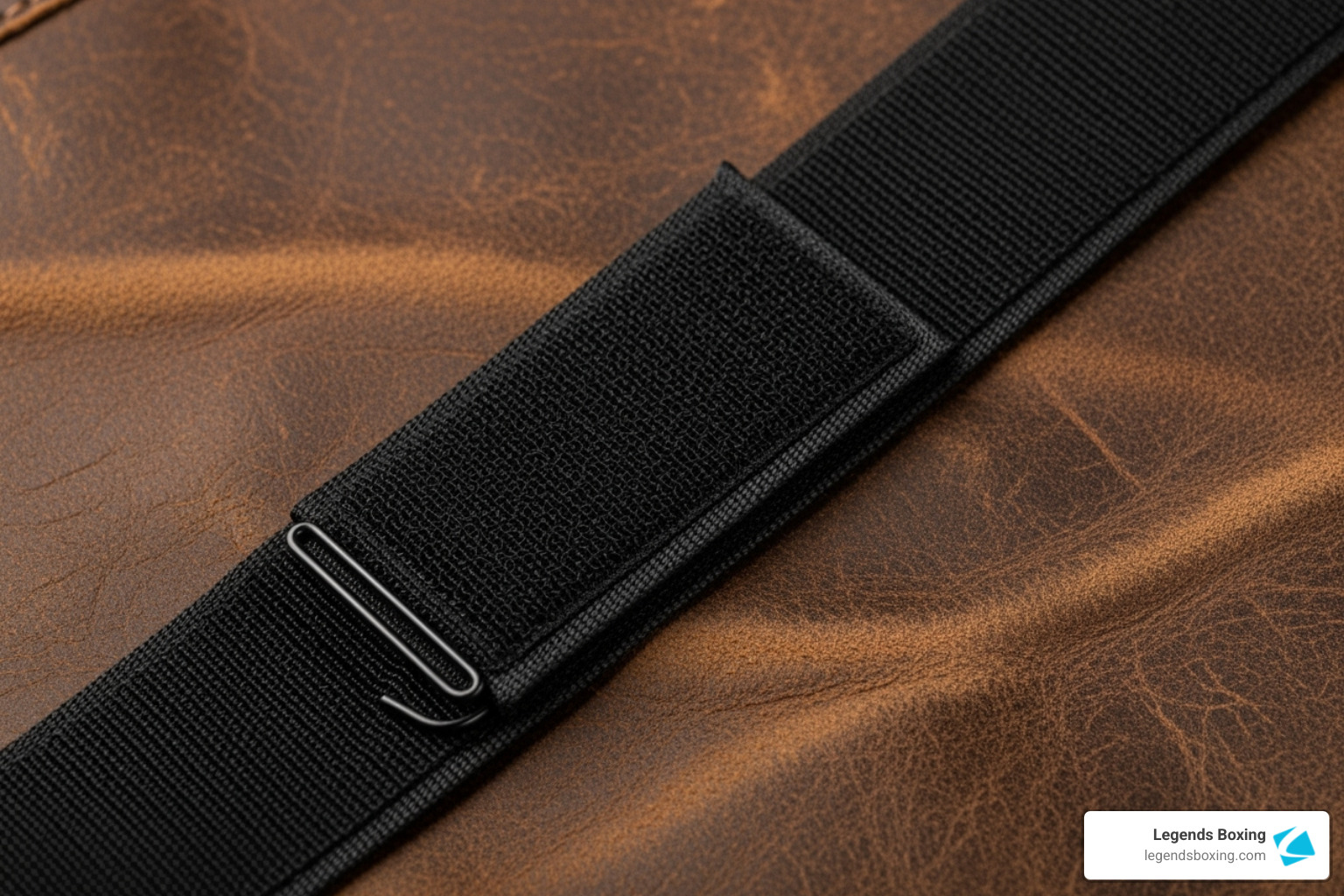Glove Up: Your Essential Guide to Boxing Glove Selection
Why the Right Gloves Matter
How to choose boxing gloves is one of the most important decisions you'll make on your boxing fitness journey. The wrong gloves can lead to hand injuries, poor technique, and a frustrating experience that kills your motivation.
Quick Answer: How to Choose Boxing Gloves
- Match your training goal: Training gloves (12-14oz) for general workouts, sparring gloves (16oz) for partner work, bag gloves for heavy bag training
- Choose the right weight: Based on your body weight - lighter people use 12-14oz, heavier people use 14-16oz for training
- Pick quality materials: Leather lasts longer but costs more, synthetic works fine for beginners
- Get the right closure: Velcro for convenience in fitness classes, lace-up for maximum wrist support
- Ensure proper fit: Snug but not tight, with room to wiggle fingers when wearing hand wraps
As a common scenario shows: a beginner unsure whether to buy sparring gloves or bag gloves, leading to confusion about weight and padding. This confusion is understandable, as gloves range from 8oz competition gloves to 20oz heavyweight training gloves, each for a specific purpose.
The stakes are high. Your hands contain 27 small bones that are easily broken. The right gloves don't just improve your workout—they protect your most valuable assets and help you punch with proper form for maximum speed and power.
I'm Robby Welch, National Head Coach for Legends Boxing. With over two years of experience, I've helped thousands of members choose the right gloves for their fitness goals and have trained our coaches nationwide for our comprehensive boxing programs.

At Legends Boxing, we believe choosing the right boxing gloves is crucial for performance and safety. It ensures you get the most from every punch, whether you're hitting the heavy bag, working mitts, or sparring. We want you to feel confident and protected, turning every session into a fun, results-driven workout. Understanding these factors will help you make an informed purchase that meets your training needs and gets you ready for what to expect at your first class.
Step 1: Match the Glove to Your Training Goal
The first and most critical step in choosing boxing gloves is to understand their intended use. Not all gloves are created equal; each type is designed with specific padding and protection to suit different training activities. Using the wrong glove for the wrong purpose can lead to injury and prematurely wear out your equipment.
Training Gloves: The All-Rounder
Training gloves are the most versatile option, making them an excellent choice for beginners or anyone wanting a single pair for general fitness classes. They offer a balanced mix of padding and protection suitable for various activities.
- Versatility: These gloves are designed for a mix of bag work, pad work, and light sparring. They're a hybrid option providing adequate protection for your hands and a decent feel for your punches.
- Padding: Training gloves feature medium-density foam, striking a balance between protecting your hands and allowing you to feel your punches for technique development.
- Beginner-Friendly: If you're starting your boxing journey, especially in a fitness-focused environment like Legends Boxing, a good pair of 12-14 oz training gloves is an ideal starting point.

Sparring Gloves
When you're ready to practice with a partner, sparring gloves are essential. These gloves are specifically designed to protect both you and your opponent during controlled practice sessions.
- Partner Safety: The primary purpose of sparring gloves is to minimize the impact on your training partner. They achieve this with significantly more padding and a softer density foam.
- Extra Padding: Sparring gloves are typically heavier (most commonly 16 oz, but sometimes up to 18-20 oz). This increased weight comes from the extra layers of padding, which absorb and distribute force more effectively.
- Shock Absorption: The softer padding helps cushion blows, reducing the risk of cuts and other injuries during sparring, ensuring a safer training environment.
Bag Gloves
Bag gloves are specifically engineered for hitting heavy bags, speed bags, and focus mitts. They are built to withstand repetitive, high-impact forces while protecting your hands and wrists.
- Heavy Bag Training: These gloves have denser, firmer padding over the knuckles than sparring gloves, as their goal is to protect your hand from the bag, not a human opponent.
- Dense Padding: While they protect your hands, bag gloves also allow you to "feel" your punches more. This feedback is crucial for technique improvement. Some individuals find that gloves with too little padding on the knuckles can cause discomfort during heavy bag sessions.
- Durability: Because they endure constant pounding, bag gloves are constructed to be very robust. Using separate bag gloves prolongs the life of your sparring gloves, as the repetitive impact of a heavy bag can quickly break down their softer padding.
Competition Gloves
Competition gloves are designed for actual fights and adhere to strict regulatory standards regarding weight, padding, and construction.
- Amateur vs. Professional: There are distinct differences.
- Amateur Boxing Gloves: Fighters under the light welterweight class (141lb) typically use 10oz gloves. Fighters in divisions welterweight (152lb) through super heavyweight (over 201lb) typically use 12oz boxing gloves. Masters Division fighters (age 41 and older) typically use 16oz gloves. These often have a white knuckle area for judges to easily score clean punches.
- Professional Fighting Gloves: Fighters welterweight (147lb) and under typically wear 8-ounce gloves. Fighters in divisions super welterweight (154lb) and up typically wear 10-ounce gloves. These gloves are more compact with less padding, allowing for more impactful punches.
- Lighter Weight & Less Padding: Compared to training or sparring gloves, competition gloves are generally lighter with less padding to maximize impact while still providing some hand protection.
- Regulation Standards: Different boxing organizations, like the World Boxing Council, have specific regulations for competitions. You can learn more about their standards at the World Boxing Council standards.
Step 2: How to Choose Boxing Gloves by Weight and Size
Understanding glove weight is where many people get confused when learning how to choose boxing gloves. The weight, measured in ounces (oz), tells you how much padding your gloves contain. More padding means better protection, but it also changes how your workout feels.
Think of it this way: wearing 16oz gloves versus 10oz gloves is like the difference between winter mittens and lightweight driving gloves. Both protect your hands, but they serve different purposes.
Decoding Glove Weight (Ounces)
Boxing gloves range from 8oz to 20oz, and each weight serves a specific purpose. The key is matching the weight to your training goals and body size.
8-10oz gloves are lightweight competition gloves. They offer minimal padding for maximum speed and impact. Unless you're competing, they aren't for your fitness journey.
12oz gloves are a sweet spot for many fitness enthusiasts, perfect for pad work, light bag training, and general boxing classes. This weight often provides the right balance of protection and performance.
14oz gloves are a popular middle ground, offering more protection than 12oz gloves while still allowing good hand speed and technique development.
16oz gloves are the gold standard for sparring. The extra padding protects both you and your training partner. They're also excellent for building endurance since the added weight makes your muscles work harder.
18oz and heavier gloves are for serious protection or endurance training. Heavier fighters often use these for sparring to build arm strength and stamina.
Remember: heavier gloves don't make you hit harder. The extra weight comes from padding designed to soften your punches. If you want more power, focus on technique and strength training, not heavier gloves.

How to Choose Boxing Gloves Based on Body Weight
Your body weight plays a huge role in determining the right glove weight. Heavier people typically generate more force, so they need more padding to protect their hands and training partners.
The general rule is simple: bigger people need bigger gloves.
| Body Weight (lbs) | Recommended Glove Weight (oz) for Bag Work | Recommended Glove Weight (oz) for Sparring |
|---|---|---|
| Under 100 | 6-8 oz | 12 oz |
| 100-125 | 10 oz | 12-14 oz |
| 125-150 | 12 oz | 14-16 oz |
| 150-175 | 14 oz | 16 oz |
| 175+ | 16 oz | 16-18 oz |
If you're unsure or want one versatile pair, 12oz or 14oz gloves are excellent starting points for most fitness boxing activities.
Measuring for the Perfect Fit
Weight is only half the equation. A poorly fitting glove can cause blisters or fail to protect your hands. Always measure your hands while wearing hand wraps, as they add bulk that affects the fit.
Here's how to measure your hand circumference properly:
- Wrap your hands with the hand wraps you plan to use for training
- Open your dominant hand with fingers slightly spread
- Wrap a measuring tape around the widest part of your hand, just below your knuckles (don't include your thumb)
- Read the measurement in inches to find your size
- Test the fit by making sure you can wiggle your fingers slightly but feel secure support
Small hands (6-7.5 inches) typically need small or medium gloves. Medium hands (7.5-8.5 inches) fit well in most medium-sized gloves. Large hands (8.5-9.5 inches) need large gloves, and extra-large hands (9.5+ inches) require the biggest sizes available.
The perfect fit feels snug but not tight. You should be able to make a fist comfortably, your thumb should feel secure, and the wrist support should be firm.
Step 3: Essential Features - Materials and Closures
Once you’ve nailed down the perfect glove type and weight, it’s time to look at the details that impact your experience: the materials and closure system. These features significantly affect your glove's durability, comfort, wrist support, and day-to-day convenience.

Material Matters: Leather vs. Synthetic (Vinyl)
The material of your boxing gloves dictates how long they will last, how well they breathe, and how they’ll feel over time. When considering how to choose boxing gloves, this is a big decision.
Genuine Leather is often considered the gold standard. It's incredibly durable, lasting for years with proper care. Leather molds to the shape of your hand over time, offering a custom, comfortable fit that synthetics can’t match. As a natural material, it also breathes better, which helps reduce moisture and odors. While leather gloves are more expensive (ranging from $60 to $400), many consider them a worthwhile investment for serious training.
Synthetic Leather, often made from PU (polyurethane) or Vinyl, is much more budget-friendly, typically costing between $20 and $40. This makes it a fantastic entry-level choice for beginners. While not as durable as genuine leather, good quality synthetic gloves can still hold up well for fitness classes and moderate bag work. Vinyl is the least durable of the synthetics, best for very light use. A big plus for synthetics is they’re usually easier to clean. For anyone in a fitness class a few times a week, synthetic gloves are a practical choice.
We often find that the "sweet spot" for quality and cost is around $70-$80. Here, you typically get a good balance of durability and comfort, giving you excellent value as you learn how to choose boxing gloves.
The Great Debate: Lace-Up vs. Velcro (Hook and Loop)
How your gloves close around your wrist impacts support and convenience.
Lace-Up Gloves are the traditional choice, offering the most secure and customized fit. When laced correctly, they conform to your hand and wrist, providing unparalleled stability and wrist support. This is critical for preventing injuries when throwing powerful punches. Many professionals swear by them, but the main drawback is needing help to put them on, which isn't practical for solo training or fitness classes.
Velcro (Hook and Loop) Gloves are all about convenience. You can easily put them on and take them off yourself, making them ideal for busy fitness classes and quick adjustments. While they might not offer the hyper-customized fit of lace-ups, quality Velcro gloves still provide ample wrist support, especially with a wide strap. For the dynamic environment of a Legends Boxing class, Velcro gloves are overwhelmingly preferred for their ease of use.
Step 4: Final Checks and Long-Term Care
You've done the research and know what you want, but before you buy, a few final checks can make all the difference. Think of this step like test-driving a car—you shouldn't buy gloves without ensuring they feel right on your hands.
How to Choose Boxing Gloves: The Try-On Test
How to choose boxing gloves isn't complete without the most important step: trying them on with your hand wraps. This might seem obvious, but many people skip this and end up with gloves that don't fit properly.
Always wrap your hands first. Your hand wraps add significant volume and change how the glove fits. Trying on gloves with bare hands won't give you an accurate feel.
Once wrapped, slip into the gloves. Your fingers should have just enough wiggle room—not cramped, but not swimming in space. If your fingertips feel squished, the gloves are too small.
Make a tight fist and throw a few shadow punches. Does your thumb feel secure? Do your knuckles sit comfortably in the padding? Your hand should fill the glove without sliding around.
The wrist support is equally important. A good glove should feel like it's giving your wrist a firm, supportive hug. If you can bend your wrist excessively, that glove won't protect you during intense training.
Keeping Your Gloves in Fighting Shape
Boxing gloves take a beating from impact and sweat. They need some TLC to stay fresh and functional.
The biggest enemy of boxing gloves is moisture. After a workout, your gloves are damp. Stuffing them in a gym bag creates a breeding ground for bacteria and odor.
Always air out your gloves immediately after training. Open them up wide and let them breathe in a cool, dry place. This simple habit will extend their life and keep them from smelling.
Watch for warning signs that your gloves are wearing out. When the padding around your knuckles feels soft and squishy instead of firm, it's time for replacements. Cracks in the material are another red flag.
A persistent foul odor that doesn't go away means bacteria has taken up residence and it's time for new gloves.
For cleaning, wipe down both the inside and outside with a clean cloth after each use. A light sports equipment disinfectant can help. Glove deodorizers or cedar inserts are great investments for absorbing moisture.
Most boxing gloves need replacing every 6-12 months with regular use. If you're training 3-5 times a week, expect to be on the shorter end of that range. Worn-out padding isn't just uncomfortable—it's dangerous. Your hands are too important to risk.
Frequently Asked Questions about Boxing Gloves
When you're learning how to choose boxing gloves, certain questions come up again and again. Here are the answers to the most common concerns I hear from new members at Legends Boxing.
Do heavier gloves hit harder?
This is a common myth. No, heavier gloves don't make you hit harder—they actually do the opposite. The extra weight comes from additional padding designed to soften your punches, not amplify them.
The heavier glove is like a bigger pillow; all that extra foam absorbs impact to keep both you and your sparring partner safe.
Real power comes from proper technique, not glove weight. Focus on generating force from your core and perfecting your form. That's what we teach in our boxing fitness class—the fundamentals that actually make you stronger.
Can I use one pair of gloves for both bag work and sparring?
While it's tempting for budget reasons, it's not recommended if you want to stay safe and protect your investment.
Heavy bag work is brutal on gloves, compressing and breaking down the foam padding. After months of pounding the bag, that padding becomes dense and hard.
When you then use those same gloves for sparring, you're hitting your partner with gloves that have lost their shock-absorbing power. That's not fair or safe for your training partner.
Using separate pairs actually saves you money in the long run, as each pair lasts much longer when used for its intended purpose.
What's the difference between amateur and professional competition gloves?
The differences are significant and come down to safety versus power.
Amateur gloves (typically 10-12oz) prioritize fighter safety. They're bulkier with more padding and often feature white-tipped knuckle areas that make it easier for judges to score clean punches.
Professional gloves (8-10oz) are a different beast. They're more compact with less padding, designed to allow for maximum impact and knockout potential. Most are lace-up style for a secure fit.
Conclusion: Find Your Perfect Pair and Start Training
Navigating boxing gloves is now much simpler. Choosing the right pair is a foundational step that impacts your safety, comfort, and how much you enjoy your fitness journey. The goal is to find a glove that feels like an extension of your arm.
We've covered how type matters, matching your glove to your training. We've decoded glove weight, understanding that more ounces mean more padding for protection. We stressed that fit is personal and requires trying them on with your hand wraps to ensure a snug feel and crucial wrist support. Don't forget those important choices in materials and closures and that a little long-term care goes a long way.
Your hand protection is paramount. The right gloves are an investment in your safety and performance, ensuring you can train effectively and push your limits without worry. At Legends Boxing, we're all about helping you find that perfect match so you can focus on what truly matters: building strength, boosting endurance, and mastering those punches.
Ready to put your newfound wisdom to the test? We'd love for you to experience the Legends Boxing difference firsthand. Why not book a free workout with us? Come on in, glove up, and let's get you hitting those fitness goals!






